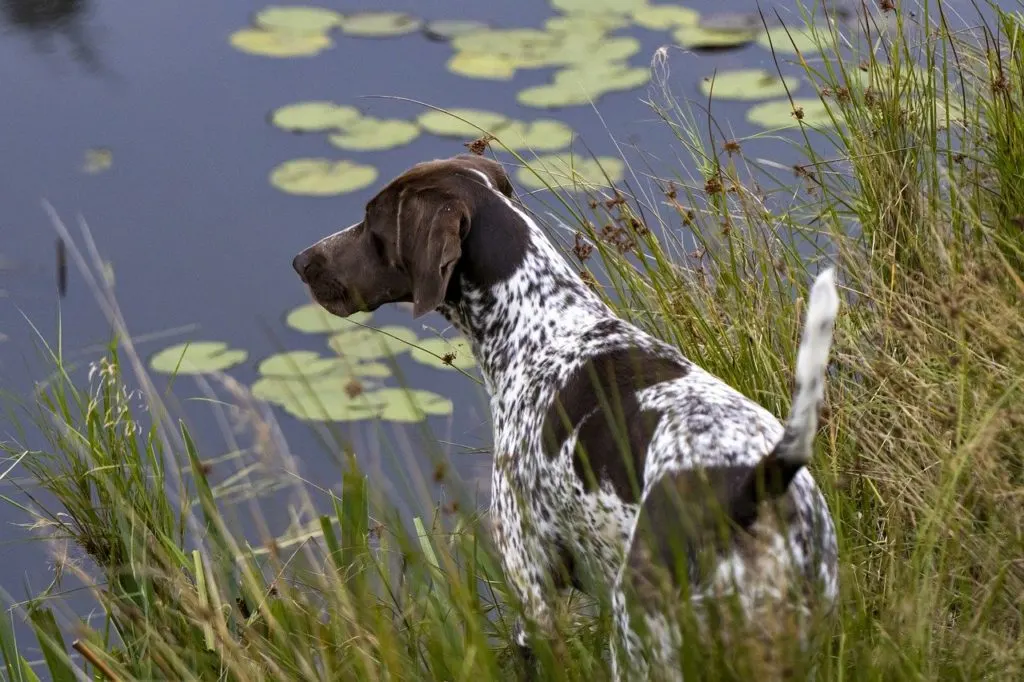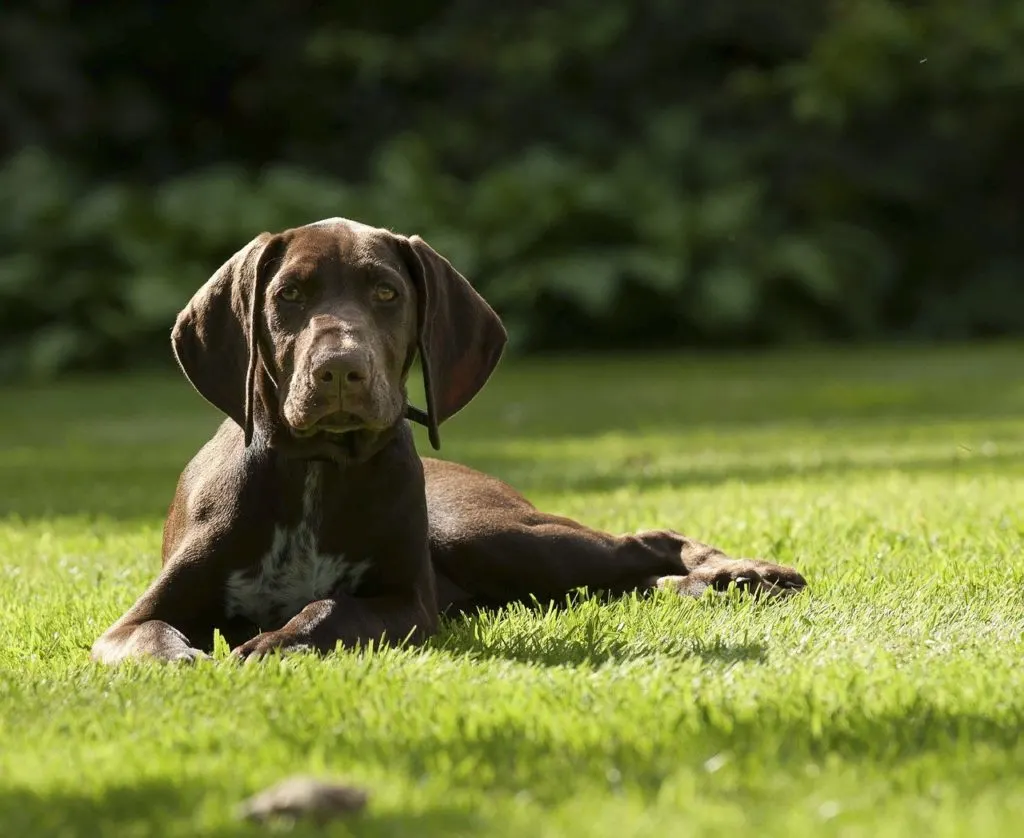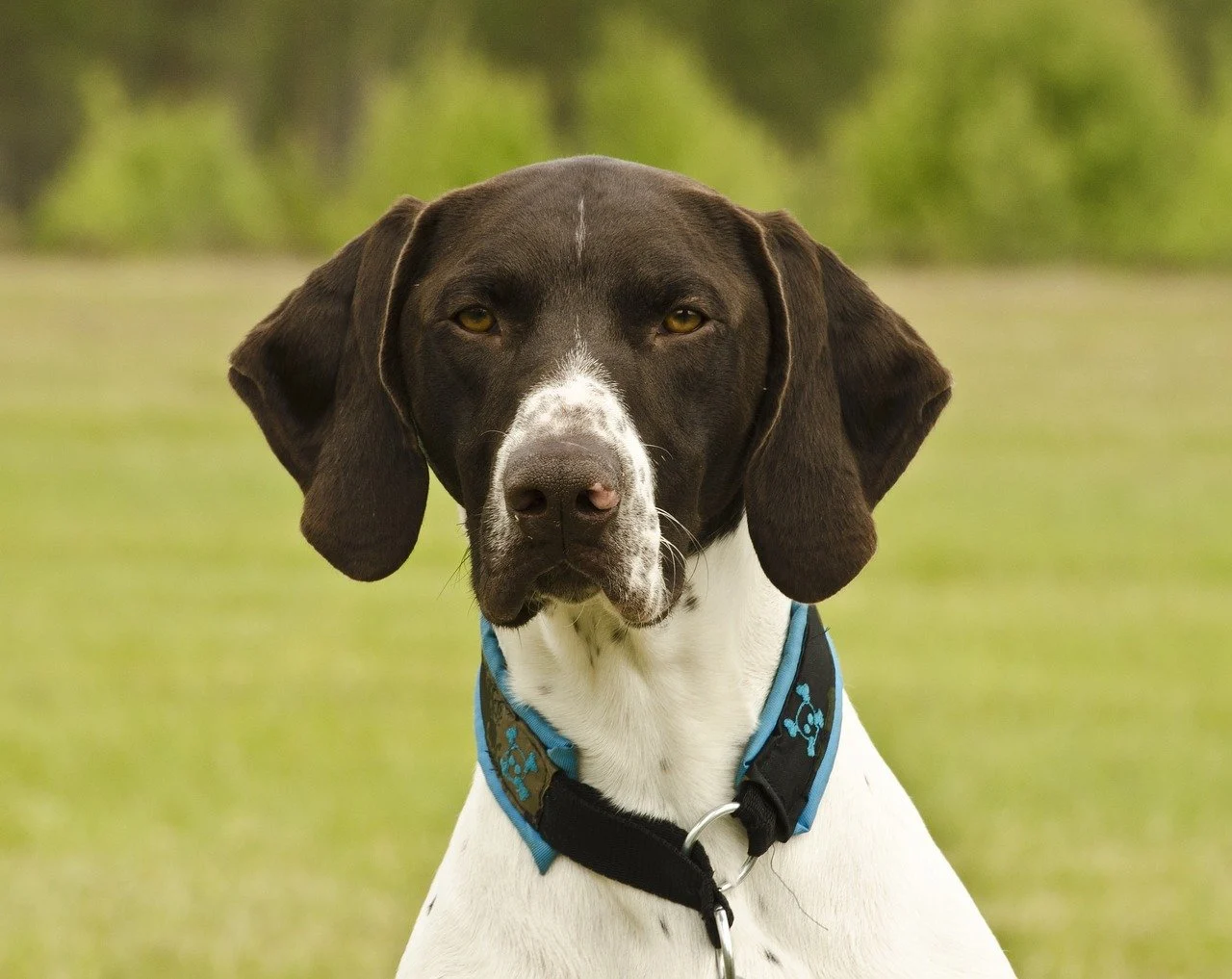The German Shorthaired Pointer is not your average family dog, but there are many things about these dogs that will surprise you. Even though this is a sporting dog breed, the many amazing characteristics of this breed still make him a good choice for some households. He is great for hunting and retrieving, but at the same time, the German Shorthaired Pointer makes a good companion dog.
But to easily figure out if this dog is for you we need to explain what a sporting dog breed even is. The American Kennel Club recognizes over 190 breeds of dogs across seven groups: working, herding, toy, hound, terrier, non-sporting, and sporting dog breeds.
Sporting dogs are naturally energetic and alert, making them pleasant and well-rounded companions. Originally designed to work closely with hunters to locate and/or retrieve game birds, and other animals. Sporting dogs are classified into four breeds: spaniels, pointers, retrievers, and setters. Various breeds are part of this group such as the Golden Retriever, Irish Setter, Weimaraner, and others. Here´s what the AKC says about sporting breeds:
Known for their superior instincts in water and woods, many of these breeds enjoy hunting and other field activities. Many of them, especially the water-retrieving breeds, have well-insulated water-repellant coats, which are quite resilient to the elements. Thinking of getting one? Just realize that most require regular, invigorating exercise.
AKC
The most important part of that statement, at least for this article, is “most require regular, invigorating exercise”. And that is exactly the case with the German Shorthaired Pointer! In this article, we will explain why this dog might not be for everyone, and who their ideal owner would be. We will also take a closer look at all of their traits and characteristics as well as their health.
German Shorthaired Pointer – What you need to know about them
Until the German Shorthaired Pointer arrived in the late 1800s, German hunters spent centuries crossing numerous breeds of dogs to get the perfect hunting companion. But, they were so successful that GSPs are now considered one of the top-winning breeds in competitive hunting contests.
According to the American Kennel Club, the GSP is most likely descended from the German Bird Dog, which is connected to the Old Spanish Pointer, which was introduced to Germany in the 17th century. According to other theories, It is also possible that different German hounds and tracking dogs, as well as the English Pointer and the Arkwright Pointer, contributed to the breed’s evolution. However, because the first studbook was not established until the late 19th century, precisely until 1870, it is hard to identify all of the dogs that contributed to the development of this breed. The American Kennel Club officially recognized the breed in 1930. The first AKC Licensed Specialty Show for the German Shorthaired Pointer was presented at the International Kennel Club Show in Chicago on March 29-30, 1941.

The breeding of German Shorthaired Pointers was influenced by World War II. As the end of the war approached, several breeders secreted their gold, gems, artwork, Lipizzaner stallions, and German Shorthaired Pointers. The best dogs were dispatched to Yugoslavia for safekeeping. But, because Yugoslavia remained behind the Iron Curtain after WWII, West German breeders were unable to access Germany’s finest GSPs, and they were forced to reconstitute their cherished breed from a limited gene pool.
Appearance and breed colors
German Shorthaired Pointers are built for speed. They have a lean appearance yet are strong and tough, as they are created for endurance and duration of exercise.
They have an alert natural body position, a long nose, and a delicate profile on their skulls. This lively and devoted dog’s athletic body and proud heads give him a serene and royal air.
With its attractive huge flapping ears and dark eyes with a soulful gaze, it’s no wonder that this intelligent and hardworking gundog is also gaining popularity as a companion.
Males range in height from 23 to 25 inches at the shoulder and weigh 55 to 70 pounds. Females range in height from 21 to 23 inches at the shoulder and weigh 45 to 60 pounds.
The coats of German Shorthaired Pointers are short and robust. GSPs are most usually seen in the liver and with white hairs. But they can come in a variety of other color combinations as well. These are some examples:
- Black German Shorthaired Pointer
- White and Black German Shorthaired Pointer
- Black Roan GSP
- Solid Liver GSP
- White and Liver German Shorthaired Pointer
- Liver Roan German Shorthaired Pointer
- Dark Brown
- Reddish Brown
- White GSP
They also have marks all over their bodies. Those marks can be patched, ticked, or a mix of the two.
Personality of GSPs
The temperament of a GSP is a result of its breeding. They inherited the best traits (and some of the worst traits) of all the breeds that were used to create them. They are bright, biddable, and loyal to their owners as working gundogs. These dogs are intelligent, affable, and eager, and the GSP is passionate in whatever he does without being scared or flighty. But, he dislikes being left alone and can develop separation anxiety. This is a house dog, not a kennel or yard dog. Also, this dog might not be a good dog for people who live in apartments. The energetic GSP needs room to be comfortable. He will adore everyone in the family, although he may have a personal favorite. And in addition to that, they are quite trainable pets and very smart!
They do not display the same enthusiasm for strangers as Labradors or Golden Retrievers. They are relaxed don´t get us wrong, but at the same time they are distant towards new faces.
When they are with their families, they are fun-loving and eager dogs who like participating in exercise-related activities.
They are devoted to their family, particularly to their primary caregiver. This implies they are one of the simpler breeds to teach, but they also prefer human interaction over time alone. Because of that, they will fit in best into a home where they will have company all the time.
GSPs, like all dogs, require early socialization. Being exposed to a variety of people, sights, noises, and experiences — when they are young. Enrolling him in puppy kindergarten is a terrific place to start. Inviting guests over regularly, as well as taking him to busy parks, stores, and on strolls, will help him improve his social abilities.
Unwanted Behaviors
Now let’s talk a bit more about the unwanted behaviors in GSPs. The German Shorthaired Pointer is not the calmest of breeds. They have been known to enjoy the sound of their voices and will need to be educated to avoid barking from an early age. Praise your puppy for quiet behavior and ignore any vocalizations to limit the amount of chatter you will hear from them as they grow.
When guests come to the house, he will almost certainly supply a watchdog voice, but this is something you can help to keep to a minimum with proper training and socialization.
GSP dogs, due to their need for companionship, can become destructive if left alone for extended periods. They are also quite agile, so if they are to be left alone outside, you must ensure that your garden is secure.
Health of German Shorthaired Pointer Dogs
Generally speaking, the GSP is a very healthy and fit dog. Many dog owners say that they never had any issues with their GSP´s health. But, just like any other breed, there are a couple of health problems you need to watch out for. Also, you need to pay special attention to the GSP’s ears. Because they have floppy ears, it’s crucial to remember to examine and clean them regularly when your puppy arrives to live with you. To make this more comfortable for the dog, start in their early years, start when they are still a couple of months old. This way the dog will get used to it and won´t make a fuss when you´re examining its ears.

The lifespan of a German Shorthaired Pointer is estimated to be 12 to 14 years. But, the UK Kennel Club states that they can live for more than ten years, the AKC states that they can live for 12 to 14 years. Most sources appear to agree that 15 years old is the breed’s maximum lifespan.
If you want your dog to live a long and healthy life you also need to pay attention to its nutritional needs. Feed them high-quality food that is rich in protein and meat. Many people also advise that the best time for feeding them is at night after all activity is done. Also, take into consideration your dog´s individual needs. Ask your vet to examine your dog to see if they need any supplements or special food to keep them the healthiest they can be.
Now, let´s take a closer look at the health problems of GSPs:
- Bloat – also known as gastric torsion, is a condition that affects many larger breeds of dogs. It occurs when a dog’s stomach fills with gas, food, or fluid and subsequently twists. If you have a puppy from one of these high-risk breeds, you can lower his chances of contracting it by promoting moderate eating. Use a slow feeder or smaller, more frequent servings, and avoid feeding him from an elevated bowl.
- Hip Dysplasia – just like all large breeds, GSPs can get hip dysplasia, a condition in which the joint is deformed, causing pain and lameness as the puppy matures. To have the best chance of avoiding this, make sure both of your puppy’s parents have had their hips graded. They should outperform the breed average of 10.
- Elbow dysplasia – another very common hereditary disease. It is related to hip dysplasia but affects the elbow joints instead.
- Osteochondritis dissecans (OCD or OD) – an inflammatory condition that occurs when the diseased cartilage separates from the underlying bone. This is a disorder that causes lameness and mobility issues in puppies due to abnormalities with bone development.
Other health problems:
- Von Willebrand’s Disease (VWD) – a blood condition that causes clotting issues. Von Willebrand’s disease is characterized by bleeding nostrils, gums, or chronic bleeding after injury or birth. Although it is treatable, it is incurable and usually does not manifest itself until the child is three years old. Ensure that both of your puppy’s parents have been tested. Your puppy will be hereditary clear if they are both clear. If one is negative and the other is positive, your puppy will not be able to get the disease but may be a carrier himself.
- Cone Degeneration – a hereditary eye disease that affects dogs causing day blindness (blindness in bright light) and Photophobia (light sensitivity). It develops between 8 and 12 weeks after birth due to the degradation of cone photoreceptor cells in the eye, which are responsible for vision in bright light.
- Neuronal Ceroid Lipofuscinosis – is a set of central nervous system degenerative illnesses that worsen over time. Disease symptoms in affected dogs appear between the ages of one and two years old and include anxiety, persistent circling, hostility, compulsive behaviors, and loss of learned skills.
Grooming needs and exercise
The sleek, short coat of the GSP is easy to groom and does not shed excessively. Brush it once a week with a firm bristle brush and bathe only when necessary. To make your GSP’s coat shine, rub it with a cloth or chamois. After exercising or working in the field, make sure to inspect your GSP’s feet. To avoid a cold, carefully dry him after hunting. GSP owners need to pay attention to their dog’s ears. Examine their ears frequently for signs of infection, such as odor, redness, or pain. If your GSP rubs his ears repeatedly, he may have an infection.
Every GSP owner will tell you that German Shorthaired Pointers have boundless energy. This is not a dog for a quick walk after work. Running, swimming, long walks, playing in a gated area, and anything else that will take the edge off their energy is required for the GSP. Two daily sessions of moderate physical activity are recommended, while there is no such thing as too much exercise with a GSP.
The muscular GSP requires a lot of workouts. Expect him to work out for an hour or two every day. He’s a terrific water dog who enjoys swimming because of his webbed feet and a water-resistant coat. So, he will love to join you in the pool if you have one.
While the GSP is generally a great family dog, because they have such high energy levels the GSP would be perfect for active families and people who love the outdoors. To fully thrive they also need a lot of positive training and a lot of love. Also, keep in mind that you need a fenced yard if you´re doing off-leash exercise because can easily run off and escape any enclosure with little difficulty.
German Shorthaired Pointer Facts
Lastly, let´s talk about some interesting German Shorthaired Pointer facts! For example, what they are like with small children and what types of game they can get.
Family life
German Shorthaired Pointers make excellent family dogs, although they can be difficult for small children. GSPs were designed by German breeders who desired companionable family pets as well as hunting dogs, and they were successful. The GSP is a very affectionate, loving companion who gets along well with children and other dogs, yet due to their boisterous nature, some experts advise against having them in households with children under the age of seven.
They will always stick to puppy behaviors
GSPs may get old, but they will always be young at heart. Though your GSP may appear physically mature at six months, it can take a few years for these dogs to progress out of puppy behaviors. So, you will end up with a puppy with the strength of a full-grown dog (hence the need for training). GSP people also note that their perfect pointer often remains active and ready to run or chase even as they mature.
Versatile hunters
German Shorthaired Pointers are very adaptable hunting dogs. These multitasking dogs can hunt, point, and retrieve, and have been trained to hunt a variety of species, including rabbits, raccoons, game birds, and even deer. They are the Swiss Army Knife of hunting dogs.

